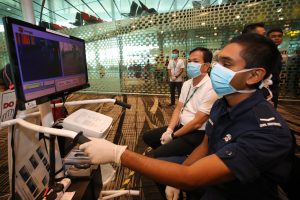On January 30, 2020 the World Health Organization declared a global health emergency as a novel coronavirus – since dubbed COVID-19 — threw the world into disarray. The outbreak is exacerbating the inherent vulnerabilities present in small states like Singapore, given the country’s small population and high degree of economic openness, on top of having to perform a difficult balancing act between the global powers.
Early on, Singapore had to implement travel restrictions lest a widespread outbreak overwhelm the country and its limited healthcare resources. Even then, Singapore now has more cases than any single country outside of China, at 77 as of February 18. But the decision to set up restrictions was not without cost. The Chinese foreign ministry singled out the United States and “some other developed countries” with sound healthcare systems for imposing travel restrictions on China. While Singapore was not directly named, this little island was among the first few countries to impose travel restrictions on China.
Singapore has cherished its relationship with China in light of the close economic ties both countries share. China has been Singapore’s largest trading partner since 2013, and the city-state is China’s largest foreign investor. And the importance of Chinese tourists to Singapore cannot be overstated. A total of 18.5 million international visitors came to Singapore in 2018; of those 3.4 million were from mainland China, the largest country of origin. Plus, Chinese visitors spend proportionally more on shopping in Singapore, shelling out twice as much shopping expenditures as visitors from other markets. The implications of restricting Chinese visitors will definitely have an impact on Singapore tourism.
The direct loss of Chinese tourists doesn’t factor in the losses incurred from tourists and business travelers from the rest of the world who have been deterred from coming. The STB chief executive predicted a drop in 18,000 to 20,000 international visitor arrivals on an average day. The 2003 SARS pandemic cost Singapore’s government a total of US$230 million in order to rescue tourism and transport industries such as airlines, restaurant, and retailers. Prime Minister Lee Hsien Loong has reported that the impact on Singapore’s economy caused by COVID-19 has already exceeded that of SARS.
Meanwhile, unlike Australia’s decision to extend travel restrictions to all Chinese travelers, Singapore is steadily allowing work pass holders who have traveled to China back into Singapore. This is because of the underlying limitations of being a small state. First Singapore needs foreign workers as there are not enough locals to meet the needs of the economy, especially in essential services such as healthcare, transport, and waste management. As of 2019, approximately 30 percent of Singapore’s labor force is made up of foreign workers. Closing Singapore’s doors to China for an extended period of time may disrupt operations in some industries. Even though the number of impacted operations is not large, according to Singapore’s Ministry of Manpower, it will still affect some sectors, for example the manufacturing industry, more than others.
Notably, this tiny island is already treading on thin ice with the Chinese government due to the initial travel restrictions. A further extension of travel restrictions could result in a worsening of China-Singapore relations, something that a small state could ill afford. The Chinese foreign minister has already slammed the Australian government for extending travel restrictions by a week, highlighting that travel restrictions are not necessary.
Singapore is well aware of its vulnerability as a small state. The 2016 incident where nine armored vehicles belonging to Singapore became China’s diplomatic hostage serves as a constant reminder. Perhaps to head off any tensions, Singapore’s government announced an assistance package to China just days after the island imposed restrictions on travel to and from the Chinese mainland. Singapore donated S$1 million dollars to the Singapore Red Cross to aid communities in China stricken by the coronavirus. Additionally, Singapore is sending to China test kits that can conduct 10,000 tests as well as three polymerase chain reaction (PCR) machines to screen people for the coronavirus.
The world is more connected than ever. This is understood not just by Singapore but also the rest of the world. As a region, ASEAN and China are preparing to hold an emergency meeting of their foreign ministers in February 2020 to discuss the outbreak of the new coronavirus. Countries, companies, and nonprofits from around the world are sending funds and supplies to help combat the epidemic to stop the spread and alleviate supply shortages.
Hui Ying Lee is a Senior Analyst with the S. Rajaratnam School of International Studies (RSIS), Nanyang Technological University (NTU), Singapore.
































